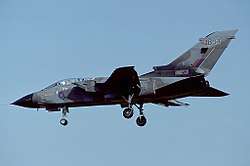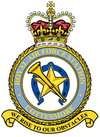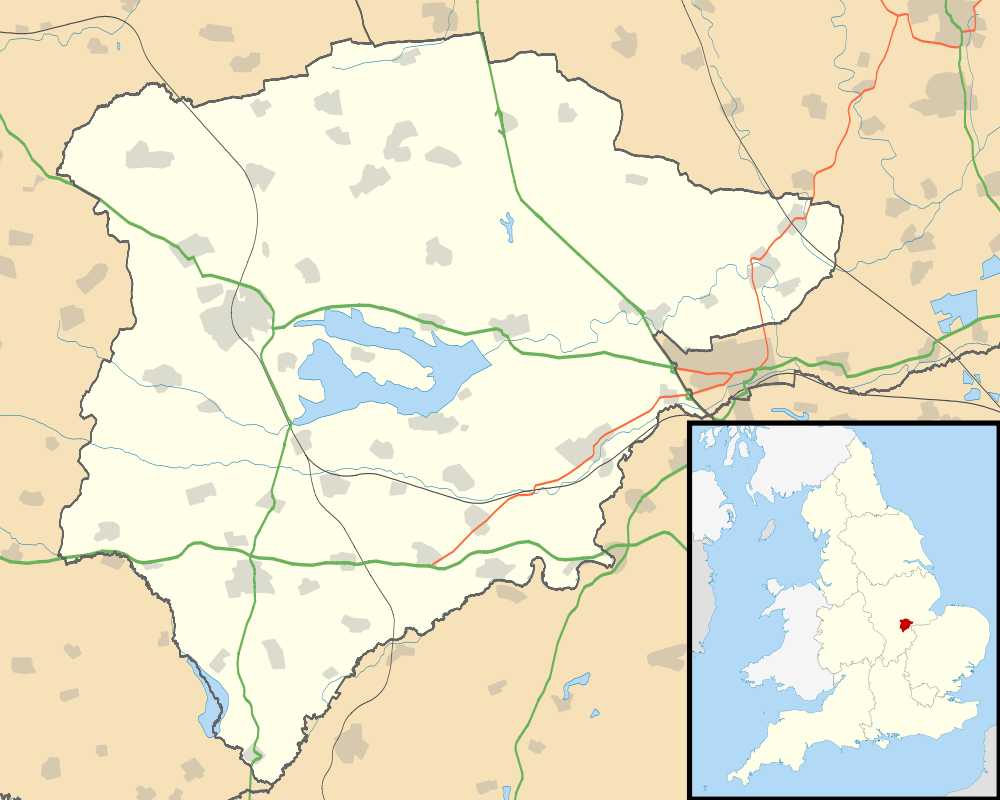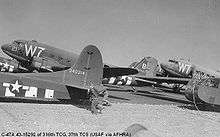RAF Cottesmore
| RAF Cottesmore | |||||||
|---|---|---|---|---|---|---|---|
| Near Cottesmore, Rutland in England | |||||||
 | |||||||
 We Rise to Our Obstacles[1] | |||||||
 RAF Cottesmore Location within Rutland | |||||||
| Coordinates | 52°43′46″N 000°39′05″W / 52.72944°N 0.65139°WCoordinates: 52°43′46″N 000°39′05″W / 52.72944°N 0.65139°W | ||||||
| Type | Royal Air Force station | ||||||
| Area | 379 hectares[2] | ||||||
| Site information | |||||||
| Owner | Ministry of Defence | ||||||
| Operator |
Royal Air Force (1938–1942 and 1945–2012) United States Army Air Forces (1943–1945) | ||||||
| Condition | Closed | ||||||
| Site history | |||||||
| Built | 1936 | ||||||
| In use | 1938–2012 | ||||||
| Fate | Transferred to the British Army and became Kendrew Barracks. | ||||||
| Airfield information | |||||||
| Identifiers | IATA: OKH, ICAO: EGXJ, WMO: 03453 | ||||||
| Elevation | 141 metres (463 ft) AMSL | ||||||
| |||||||

Royal Air Force Station Cottesmore or more simply RAF Cottesmore is a former Royal Air Force station in Rutland, England, situated between Cottesmore and Market Overton. The station housed all the operational Harrier GR9 squadrons in the Royal Air Force, and No. 122 Expeditionary Air Wing. On 15 December 2009 it was announced that the station would close in 2013 as part of defence spending cuts, along with the retirement of the Harrier GR9[3] and the disbandment of Joint Force Harrier. However the formal closing ceremony took place on 31 March 2011 with the airfield becoming a satellite to RAF Wittering until March 2012.[4]
In July 2011 Defence Secretary Liam Fox announced plans for it to be the airfield for one of five of the Army's Multi-Role Brigades. In April 2012 it was renamed Kendrew Barracks after Major General Sir Douglas Kendrew.[5]
Station badge
The badge of RAF Cottesmore consisted of a hunting horn, a five-pointed star and a horseshoe. The description is "in front of a horseshoe a mullet overall a hunting horn in bend". The hunting horn symbolises the location in foxhunting country and the link with the Cottesmore Hunt; the American Star recalls the time the Station was a United States Army Air Force base; the inverted horseshoe is a traditional emblem of Oakham and the County of Rutland.
The motto "We rise to our obstacles"[6] is both a reference to the Cottesmore Hunt and was intended to convey the spirit with which the Royal Air Force confronts difficulties. The badge was granted in 1948.
The badge appears on the nameplate of the LNER Peppercorn Class A1 60163 Tornado steam locomotive that was named by HRH The Prince of Wales and The Duchess of Cornwall on 19 February 2009.
History
Royal Air Force
RAF Cottesmore opened on 11 March 1938. The station was used mainly for training, and the first squadrons were equipped with Vickers Wellesley aircraft, but soon converted to Fairey Battles. Later RAF Bomber Command took over the airfield, again as a training station, flying Handley Page Hampdens.
These units remained in residence until a few days before the outbreak of war in 1939 when they were sent to RAF Cranfield to serve as a pool providing replacements for combat losses. Their place at Cottesmore was taken by Nos. 106 and 185 Squadrons, moving in from RAF Thornaby with Hampdens.
However, with the outbreak of war, the aircraft and crews were sent to locations in the north and west, as enemy air attacks were expected over the southern half of England. As these never materialised, the Hampdens returned in the spring of 1940 and No. 185 Squadron became the Hampden operational training unit, No. 14 Operational Training Unit RAF.
Cottesmore's Hampdens' first trespass into hostile airspace was a leaflet dropping operation over northern France. In October 1940, 106 Squadron moved to RAF Finningley while No. 14 OTU remained training crews for Bomber Command, its Hampdens and HP.53 Herefords being replaced by Vickers Wellingtons in 1942. Training continued for three years and three months until August 1943 when No. 14 OTU moved to RAF Market Harborough.[7]
United States Army Air Forces
On 8 September 1943 the United States Army Air Forces took the facilities over, under the designation USAAF Station 489, flying troop transport aircraft. In anticipation of the station's future use by airborne forces, 32 Horsa gliders were delivered for storage in July 1943.
316th Troop Carrier Group

The 316th Troop Carrier Group began to arrive at Cottesmore on 15 February 1944 when 52 C-47 and C-53 transports began flying in from Borizzo Afld., Sicily. Operational squadrons and fuselage codes of the group were:
- 36th Troop Carrier Squadron (4C)
- 37th Troop Carrier Squadron (W7)
- 44th Troop Carrier Squadron (6E)
- 45th Troop Carrier Squadron (T3)
The 316th TCG was part of the 52d Troop Carrier Wing.
Post-war
Cottesmore was officially handed back to the RAF on 1 July 1945. As a pre-war base with permanent buildings, it was unlikely that it would remain vacant for long. Cottesmore again became a training station, hosting 7 FTS with Percival Prentice basic training aircraft and the North American Harvard trainer for advanced training - later replaced by the Boulton Paul Balliol which had a Rolls-Royce Merlin engine.
In 1954 English Electric Canberras were moved in, the first time front-line combat aircraft had been based there, but all had left by the end of 1955.

In 1957 it was announced that Cottesmore would become a base for aircraft of the V bomber force, carriers of Britain's nuclear deterrent. The squadrons carried out Quick Reaction Alert duties using Handley Page Victor and later Avro Vulcan bombers, until 1969. When they left the base was used by 90 Signals Group. Flight Checking, Trials and Evaluation Flight (FCTEF) used 98 Squadron (Canberras) and 115 Squadron (Varsity and Argosy) to provide ILS and radar trials and checking services to RAF airfields around the world. No. 231 Operational Conversion Unit moved into Cottesmore on 19 May 1969 equipped with Canberras, staying until 12 February 1976 when it moved to RAF Marham.[8]
No. 360 Squadron, an electronic countermeasures (ECM) squadron flying Canberras, moved to RAF Cottesmore in April 1969. 360 Squadron moved in September 1975 to RAF Wyton.
Cottesmore became home to the Tri-national Tornado Training Establishment (TTTE). Established in July 1980 and officially opened on 29 January 1981, the centre undertook training of new Panavia Tornado pilots from the RAF, Luftwaffe, German Navy and Italian Air Force.
The TTTE closed in 1999, and after a period of refurbishment was replaced by the Harriers of Nos 3 and 4 squadrons; these were later joined by 800 and 801 Naval Air Squadrons to form Joint Force Harrier.
With the introduction of the Eurofighter Typhoon into RAF service, No.3 Sqn moved to RAF Coningsby and No 1 Sqn moved from RAF Wittering.
Closure
In early December 2009, it was announced the station would close due to funding cut-backs, in part to help pay for additional helicopters for British operations in Afghanistan.[9]
In 2010, No. 4 Squadron RAF disbanded, with No. 20 Squadron RAF re-badging as No 4 (Reserve) Squadron.
The station became a satellite to RAF Wittering on 31 March 2011 with a civic parade and flypast to mark the disbandment of No 1 Sqn RAF, 800 NAS, 801 NAS and JFH. In July 2011 it was announced that Cottesmore would house the Army's East of England Multi-Role Brigade.[10]
Station commanders
- AVM James Johnson CB CBE 1957-1960
- Air Cdre Robert Weighill CBE DFC 1961-1964
- Group Captain Jack Garden 1965-1967
- Gp Capt L G Bastard 1969-1971
- AVM Kenneth Kingshott CBE DFC 1971
- Air Cdre Alan Jenkins 1973
- Gp Capt Brian Gubbins 1975
- Air Mshl Sir Michael Simmons KCB, AFC 1980-1982
- Air Commodore Terry Carlton, 1982 - 1984
- AVM Peter Goddard, CB 1984-1986
- Air Chf Mshl Sir Peter Squire DFC 1986-1988
- AVM Ronald Elder CBE 1988-1990
- AVM Thomas Rimmer CB OBE 1990-1992
- Air Marshall Philip Sturley CB MBE 1992-1994
- Group Captain Malcolm Ball AFC 1994 -1996
- AVM Andrew White CB 1996-1999
- Group Captain David Walker 1999-2001
- Group Captain Michael Harwood 2001-2003
- Group Captain Andrew Golledge 2003-2005
- Group Captain Sean Bell 2005-2007
- Group Captain Ken McCann 2007-2009
- Group Captain Gary Waterfall 2009 – Station closure in 2011
Kendrew Barracks
The Army officially took over the site in April 2012. It is now home to the 2nd Battalion Royal Anglian Regiment, who moved from Dhekelia Garrison in Cyprus. A second regiment, 7 Regiment Royal Logistic Corps, moved to the base in 2013.
Kendrew Barracks was officially opened in October 2012 by the Duke of Gloucester.[11]
See also
References
![]()
Citations
- ↑ Pine, L.G. (1983). A dictionary of mottoes (1 ed.). London: Routledge & Kegan Paul. p. 264. ISBN 0-7100-9339-X.
- ↑ "Defence Estates Development Plan (DEDP) 2009 - Annex A" (PDF). GOV.UK. Ministry of Defence. 3 July 2009. p. 19. Retrieved 19 November 2017.
- ↑ "Harrier jets take off on retirement". London Evening Standard. 16 December 2010. Archived from the original on 18 December 2010. Retrieved 4 July 2011.
- ↑ "Last parade as RAF base shuts". This is Leicestershire. 1 April 2011. Archived from the original on 2 April 2011. Retrieved 4 July 2011.
- ↑ "Cottesmore Army base named as Kendrew Barracks" Stamford Mercury, 23 April 2012
- ↑ Pine, L.G. (1983). A dictionary of mottoes (1 ed.). London: Routledge & Kegan Paul. p. 264. ISBN 0-7100-9339-X.
- ↑ Halpenny 1981, p. 00.
- ↑ Sturtivant, 1997, p. 232
- ↑ Norton-Taylor, Richard; Sparrow, Andrew (15 December 2009). "RAF Cottesmore base to close in defence budget reshuffle". The Guardian. Retrieved 4 July 2011.
- ↑ "Cottesmore saved by plan to host new Army brigade" BBC News 18 July 2011
- ↑ "Duke officially opens Kendrew Barracks" Rutland Times 11 October 2012
Bibliography
- Halpenny, B.B. Action Stations: Wartime Military airfields of Lincolnshire and the East Midlands v. 2. Cambridge, Cambridgeshire, Patrick Stephens Ltd, 1981. ISBN 0-85059-484-7.
- Freeman, Roger A. (1994) UK Airfields of the Ninth: Then and Now 1994. After the Battle ISBN 0-900913-80-0
- Maurer, Maurer (1983). Air Force Combat Units Of World War II. Maxwell AFB, Alabama: Office of Air Force History. ISBN 0-89201-092-4.
- Sturtivant, R.C. (1997) Royal Air Force Flying Training and Support Units. Air-Britain (Historians) Limited. Tunbridge Wells, Kent. ISBN 0-85130-252-1.
- USAAS-USAAC-USAAF-USAF Aircraft Serial Numbers—1908 to present
External links
| Wikimedia Commons has media related to RAF Cottesmore. |
.svg.png)